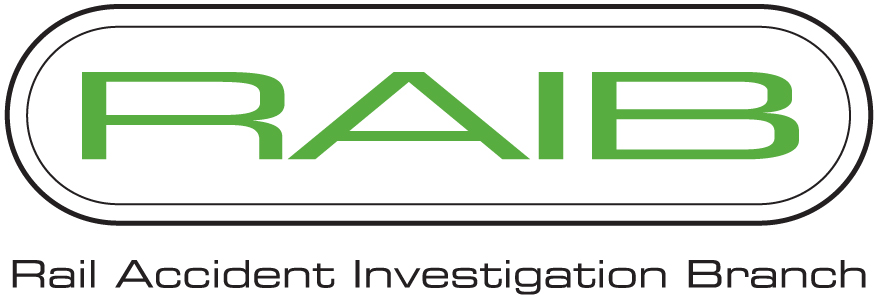Summary of learning - 3. Managing risk at the platform-train interface - v5. May 2025
Published 2 April 2020
1. Purpose of this summary
The purpose of this document is to provide a repository of some of the most important areas of learning identified in RAIB’s investigations to date, cross-referenced to relevant reports. It therefore provides a reference source for those looking to understand real-world railway safety issues and potential control measures.
When preparing this document, RAIB has selected those issues which:
- have recurred in different RAIB investigations
- have still to be fully addressed
- could be a factor in the cause of a fatal accident
RAIB is aware that many of the issues raised have already been the subject of actions by duty holders when responding to RAIB recommendations, or are in the process of being addressed. The inclusion of a topic in this document should not be taken to mean that no action has been taken in response to relevant recommendations. However, its inclusion indicates that RAIB is of the view that the issue still needs to be actively managed by duty holders.
The current status of each recommendation made by RAIB can be checked by reference to the Index of RAIB recommendations, and details of the actions taken are published by ORR.
It is not the purpose of this document to quantify the risk associated with each of the identified safety issues. Readers seeking to understand the overall risk of harm associated with various dangerous events should refer to RSSB’s Annual Safety Performance Report. This presents historical information on actual harm caused, and estimates of risk based on extensive modelling.
2. Overview
Every day, several million people get on and off trains at stations. While almost all of these events happen safely, there are several ways in which they can go wrong. As well as slips, trips and falls while getting on and off, people can be trapped in the train doors and dragged, and fall onto the track and be struck by the train. Passengers can also be hurt by falling through the gap between train and platform. The consequences of such events are often very serious.
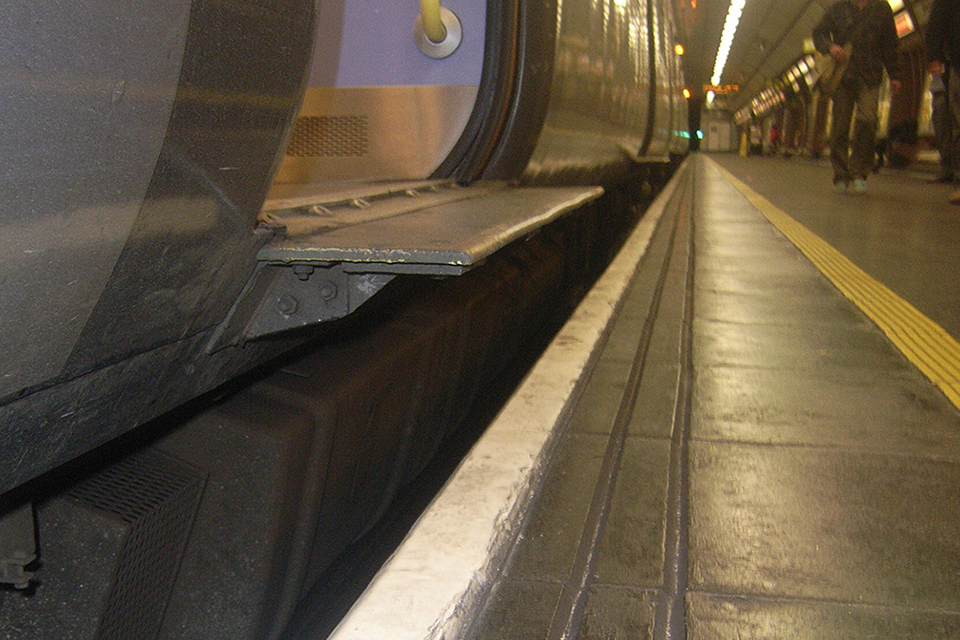
Train doors, step, gap and platform - a hazardous area.
An important hazard that the railway is able to control is that from ‘trap and drag’ incidents. Checking that everyone and everything is clear of the train before it departs is crucial, but it can be challenging to manage the consequences of the way people behave, and the sheer numbers of people on platforms can also make it hard for staff to see all the train doors. If somebody is trapped and dragged by a departing train or tram, it is important that whoever is responsible for starting the vehicle can see what is happening and act quickly to stop the movement.
3. Important areas for safety learning
The areas of significant concern to RAIB fall into the six main themes described below.
3.1 Door control systems
Door control systems are not always capable of detecting thin objects trapped in closed and locked doors. If a trapped object is not detected, trains can move off dragging whatever is trapped along the platform, with a high risk of death or serious injury as a result.
At Notting Hill Gate in 2018, a passenger’s bag became trapped in the doors as they attempted to board the train. The trapped bag was not detected by the door control system. The passenger was unable to free herself from the bag, and was dragged along the platform and into the tunnel as the train departed, suffering serious injuries (report 14/2018).
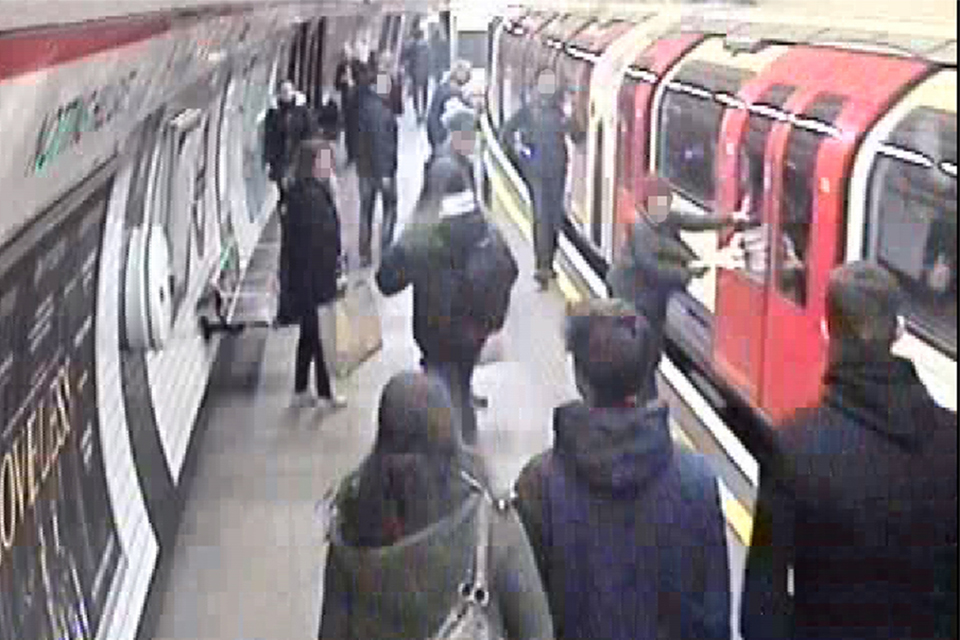
Passenger with bag trapped in train doors at Notting Hill Gate.
At Enfield Town station (safety digest 09/2024), a passenger’s hand became trapped in the doors of a train about to depart. Although introduced into service in 2019, the train involved in this accident was not fitted with sensitive door edges or anti-drag systems even though these had been fitted to other trains of the same type by other operators. The passenger was forced to run alongside the train, eventually losing their footing while being dragged along the platform, and sustaining minor injuries and psychological distress.
We believe that more needs to be done to enhance the ability of door control systems to detect the presence of a trapped object. Technology such as sensitive edge and anti-drag systems are already being used by some operators, and could be more widely adopted, particularly when new trains are being ordered and specified. We have recommended that these measures should be used on new London Underground trains, and trams.
3.2 Final safety checks
A number of RAIB investigations have found that railway and tramway staff were not aware of the limitations of door detection systems. Staff involved in train dispatch were relying on the door interlock indications to confirm that nothing was trapped, and that it was safe for the train or tram to depart. This reliance on interlock systems can lead staff to overlook the importance of a final safety check. Possibly as a consequence of this, we have seen staff making only a cursory final safety check and not detecting problems which can be seen when looking at CCTV images or along the outside of the train or tram to check that nothing is trapped in the doors.
At Bushey in 2018, a passenger’s arm became trapped in the closing doors, and the passenger was dragged along the platform. The train conductor believed that the extinguished body side lights and the illuminated interlock light in their cab showed that nothing was trapped in the closed doors. The conductor told the passenger to stand clear of the train and signalled to the driver to start (safety digest 07/2018).
As a result of our Hayes & Harlington investigation (report 12/2016), we recommended that train and tram operating companies should introduce measures to address the risk of over-reliance on the door control system to detect trapped objects, and emphasise to their staff how the limitations of the detection systems reinforce the need for the final safety check by train dispatchers. We also called for measures to enhance the quality of the view of the platform-train interface, particularly in crowded conditions as a result of our Clapham South investigation (report 04/2016).
At Radford Road, Nottingham, in 2017, a pushchair, fortunately unoccupied, became trapped in tram doors and was dragged all the way to the next stop (report 15/2018). We recommended that the tram operator should review all aspects of its arrangements for minimising the risk of this happening. We found that there was a lack of understanding of risk in this area, which may extend across the tram industry.
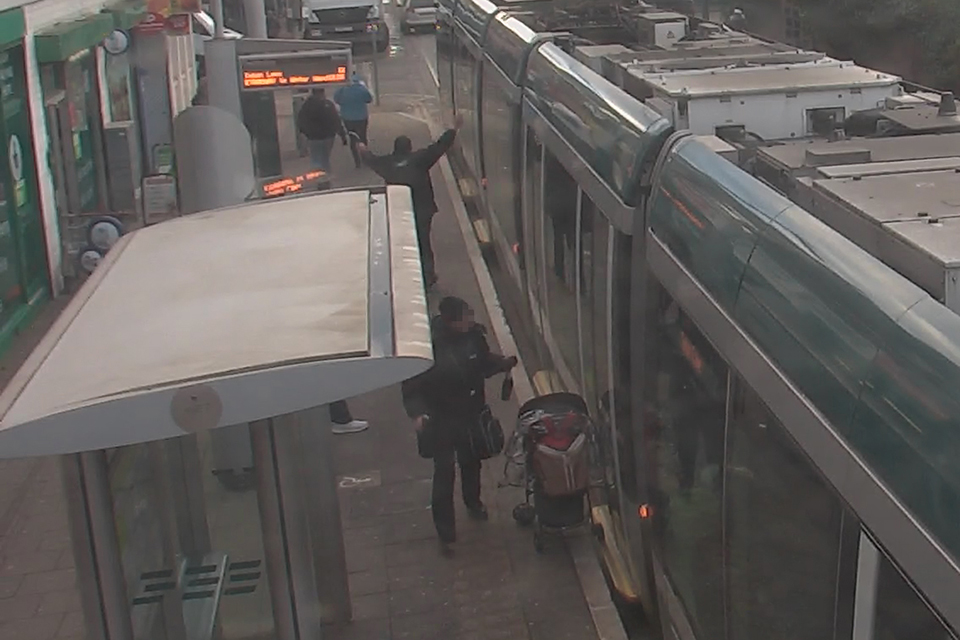
Pushchair trapped in tram doors at Radford Road, Nottingham in 2017.
A further incident occurred on the Nottingham tram network at Beeston Centre tram stop in 2023 (safety digest 04/2023). A passenger was seriously injured when they fell to the ground after their walking stick was trapped in the tram’s closing doors and they were dragged by the tram. The tram driver had not completed an effective final safety check before departure and the walking stick was not detected by the tram’s door control system.
At Shudehill, Manchester, in 2022, a passenger’s bag became trapped in the doors of a tram. The passenger was dragged by the tram and fell onto the platform, sustaining injuries to their face and hand (safety digest 04/2022). The accident occurred because the driver did not complete a final safety check before starting the tram. The driver later stated that they were unaware that thin objects could be trapped in the closed doors and not be detected by the door interlock.
At Wood Street station (safety digest 01/2022), north-east London, in January 2022, a train travelled for 20 metres with a passenger’s hand trapped in the door. The driver was unaware that the passenger was trapped and was unaware that a passenger’s hand could be trapped in the closed doors and not be detected by the door interlock.
In June 2022, there were three further incidents of passengers becoming trapped in doors and dragged along the platform in north London (safety digest 05/2022). These further incidents involved the same class of train and operating company as the incident at Wood Street station. Despite a briefing note issued to all drivers following the accident at Wood Street, reminding them of the risk of relying on the interlock, one of the drivers involved in the June incidents was still unaware of the limitations of the interlock. RAIB also found that one of the trains involved had a misaligned camera which reduced visibility of one of the passengers involved.
At Chalk Farm on the London Underground (report 06/2024), a passenger was attempting to board a Northern line train but stopped as the doors began to close. Their coat nevertheless became trapped in the doors. The train travelled for approximately 20 metres dragging the passenger until the coat became free and the passenger fell to the ground, sustaining minor injuries. The train operator had not detected the passenger was close to the doors before starting the train and did not see that they were trapped during departure from the platform.
At Enfield Town station, the driver’s train safety check did not detect that the passenger was standing close to the train or was trapped in the doors. Witness evidence indicated that the driver may have developed a belief that it was safe to depart based on the images shown on the monitors at the point where they closed the doors.
3.3 Loss of attentiveness
The repetitive nature of the driving task on metros, suburban trains and trams, particularly on trains that operate automatically, can lead to a loss of attentiveness on the part of drivers. This can result in important visual cues during the dispatch process being missed, and result in people being dragged when the vehicle moves off.
At Elstree & Borehamwood in 2018 (report 03/2019), a passenger and their dog were boarding a train. The doors closed in front of the passenger and the dog’s lead became trapped in the doors. The train departed, dragging the dog off the platform and leading to its death, while the passenger remained on the platform. The driver was in the habit of carrying out the final safety check in significantly less time than other drivers on the same route and did so on this occasion. Carrying out the check in a shortened time meant that even a slight loss of attention could have led to the driver missing the passenger and their dog in the CCTV image.
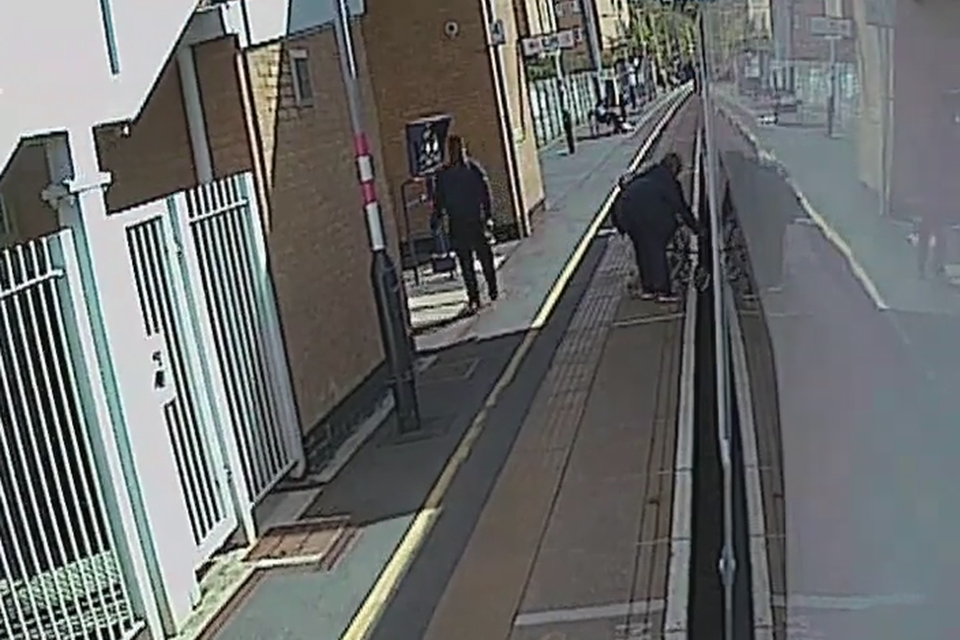
Passenger tries to free dog trapped in train doors at Elstree & Borehamwood.
At Stratford London Underground station in 2023 (report 01/2025), a passenger fell from the platform onto the track and lay undiscovered for around 5 minutes before being struck by an arriving train. The presence of the passenger remained unknown and a further three inbound trains entered the platform where the passenger was lying. The passenger was fatally injured. A possible underlying factor to the accident was that train operator alertness can decrease when trains are operating in automatic train operation mode, because they have less active input into the control of the train.
We have recommended measures to support train and tram drivers in maintaining attention and awareness, particularly when associated with automatic train operations (Notting Hill Gate, Archway and Chalk Farm, Stratford), and research and development of technology to assist staff responsible for train dispatch to determine that passengers are clear of the train (Elstree & Borehamwood, Archway and Chalk Farm).
3.4 Interaction of passengers with trains
Research from RSSB has shown that 58% of passengers mistakenly believe that the doors of a train will reopen like a lift door if they are obstructed. This misconception may mean that passengers do not fully understand the risk associated with becoming trapped in train doors.
At Notting Hill Gate, as described above, the passenger whose bag became trapped believed that the doors would reopen, as they had seen this happen to other people, probably on other types of train which are fitted with sensitive edge door control systems.
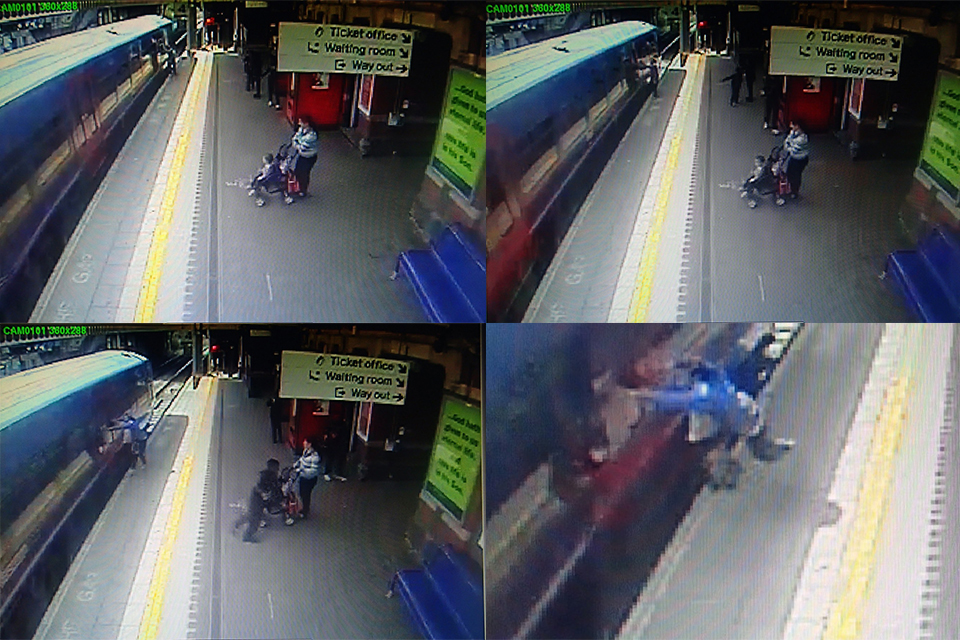
Passenger trapped in closing doors and dragged along the platform at Hayes & Harlington.
We saw another example of behaviour influenced by this belief at Hayes & Harlington in 2015, when a passenger placed their hand between the closing doors in the expectation that they would reopen and was subsequently dragged along the platform. In our report on this accident, we recommended research to better understand the way that passengers interact with rail vehicle/tram doors. At Wood Street and Enfield Town stations, as described above, the passengers involved attempted to board the train after the door closing sequence had begun. As the passenger attempted to board the train, they placed their hand between the closing doors.
3.5 Gaps between platforms and trains
Gaps between platforms and trains can occur in the following areas:
- door step plate to platform edge (also known as the stepping-gap)
- train bodyside and the platform edge
- inter-vehicle gap between coaches
Curved platforms result in narrowed and enlarged gaps at different points along the train and platform edge.
At Waterloo station on the London Underground in May 2020 (report 05/2021), a passenger fell into the wide gap between a train and a curved platform, while the train was stationary. No one noticed them fall, and they subsequently died, and was found after the train departed and a following train had entered the station. This is not the first time RAIB has investigated accidents in which a significant gap between the train and the platform was a factor.
At James Street, Liverpool, in 2011, a passenger was killed when they fell under a train as it began to move (report 22/2012), and a similar accident, though its outcome was not fatal, occurred at Charing Cross station, London in 2012 (report 10/2013). In both cases there was a large gap between the platform and the side of the train. We have recommended that the industry considers the actions needed to mitigate the risk created by these large gaps and ensures that its risk assessments take account of platforms where such gaps exist. This is particularly important when considering the risk to passengers whose ability to negotiate the platform-train interface is impaired.
3.6 Accidents involving passengers whose use of the railway exposes them to greater risk
Some passengers may require additional assistance or accommodations while traveling. Some of these groups may be exposed to greater risk on station platforms and when boarding or alighting from trains.
At Twyford (report 01/2017), a wheelchair occupied by a teenage girl moved towards the edge of a platform and came into contact with the wagons of a passing freight train. The girl suffered minor injuries. The accident occurred because the freight train’s slipstream, combined with the ambient wind, generated an aerodynamic force which was able to overcome the brakes on the wheelchair. We made recommendations that the railway industry should inform the public of the potential hazards from train slipstreams and investigate measures to improve the safety of wheelchair and pushchair users at stations.
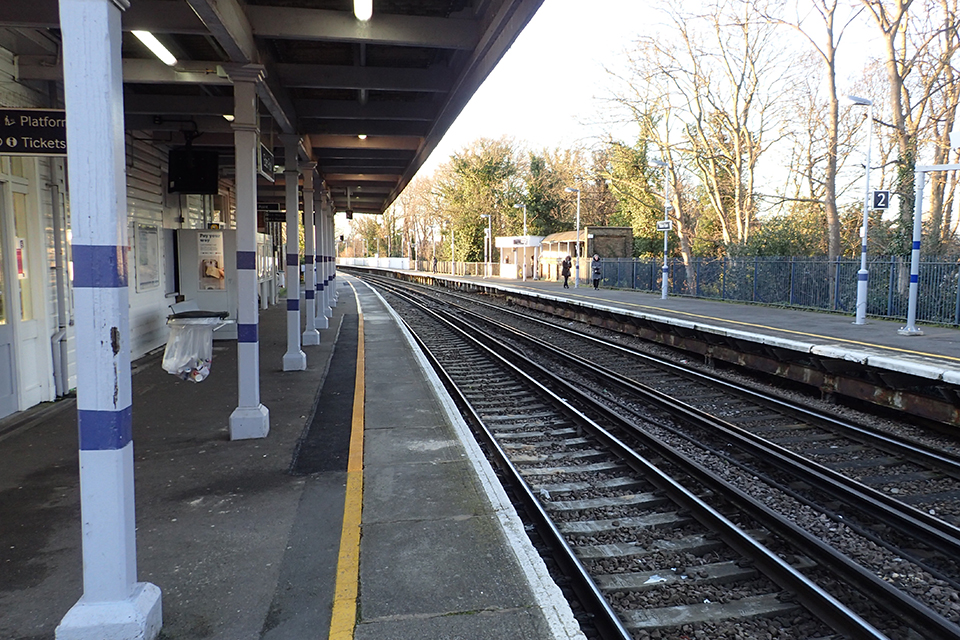
Platform with no tactile surface markings at Eden Park.
At Eden Park (report 01/2021), a visually and mobility impaired person fell from the edge of a platform into the path of an approaching train. The platform had no tactile surface markings which could have alerted the person to how close they were to the edge, and our investigation found that the railway industry’s approach to the provision of tactile surfaces had been ineffective. We recommended that the railway industry and the Department for Transport review their approach to the installation of tactile surfaces and management of risk to visually impaired passengers on station platforms.
At Loughborough Central station (report 13/2023), a visually impaired person was seriously injured when they lost their footing and fell while alighting from a train. This accident, which took place on a heritage railway, occurred because the train involved had stopped with the door used by the passenger adjacent to the platform end ramp, making it difficult for them to safely step down. Our investigation found the heritage operator had no effective processes for managing risk or learning lessons from previous incidents. We recommended that the operator review its safety management arrangements, including ensuring that the needs of disabled passengers are considered, and that heritage railways generally have access to better guidance on managing the risks around the platform-train interface.
At Archway station (report 06/2024), a 101-year-old passenger was alighting a Northern line train when the door began to close and their coat became trapped. The train departed and the passenger was dragged for approximately 2 metres along the platform before falling to the ground and the coat became free of the door. The passenger’s companion, who was holding on to them at the time, also fell to the ground. The passenger sustained serious injuries. We made recommendations concerning LUL’s understanding of risk and mitigation of the risks from trap and drag events, station dwell times and the design of the task and cab environment.
At Banbury station (safety digest 10/2024), a pram, carrying an infant, rolled towards the platform edge and came into contact with the bodyside of a train. This contact occurred while the train was moving at an estimated 35 mph and caused the pram to spin and tip over, resulting in the infant falling onto the platform surface. The infant sustained a minor injury. The accident demonstrated the importance of station operators taking appropriate steps to understand and effectively mitigate platform hazards and working collaboratively with infrastructure managers to understand and control the risks.
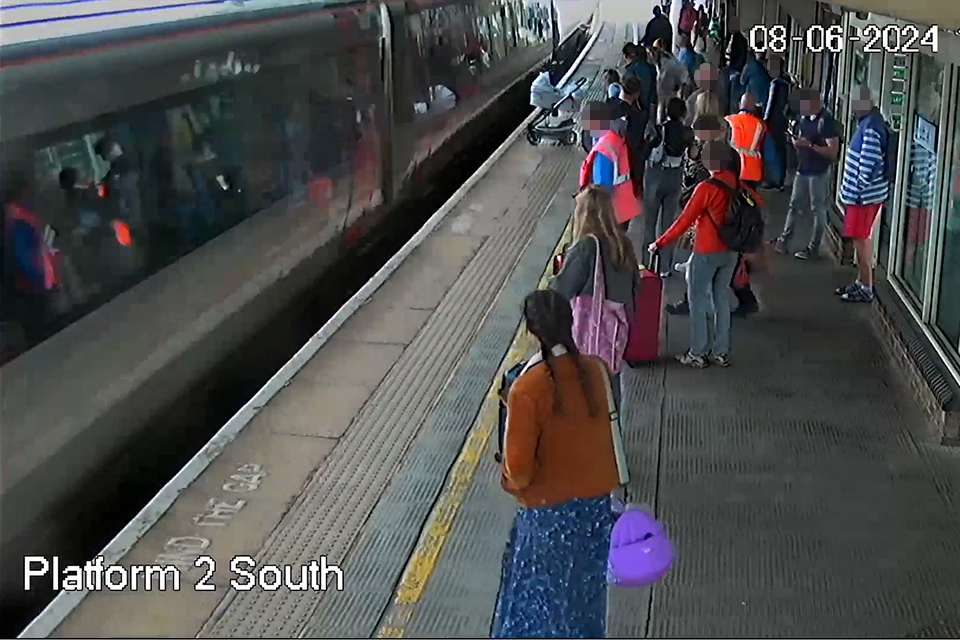
CCTV footage from Banbury station showing the pram and train moments before the accident occurred (courtesy of Chiltern Railways).
Managing the risks of wheelchairs or pushchairs rolling off platforms was also the subject of recommendations in the report into a wheelchair rolling onto the track at Southend Central and a pushchair rolling onto the track at Whyteleafe (report 17/2014)
4. Rail industry’s strategic safety groups
Relevant rail industry groups working in this field include the cross-industry Platform-Train Interface Working Group, which supports the delivery plan developed by the People on Trains and in Stations Risk Group. The working group meets every quarter to identify, assess and mitigate existing and emerging risks associated with station platforms.
5. Relevant RAIB publications
- Fatal accident at James Street station, Liverpool, 22 October 2011 (report 22/2012)
- Accident at Charing Cross station, London, 24 November 2012 (report 10/2013)
- Accidents at Southend Central and Whyteleafe stations, 28 August and 18 September 2013 (report 17/2014)
- Passenger trapped in train doors and dragged at Clapham South station, 12 March 2015 (report 04/2016)
- Passenger trapped and dragged at Hayes & Harlington station, 25 July 2015 (report 12/2016)
- Occupied wheelchair contacting passing train at Twyford station, 7 April 2016 (report 01/2017)
- Dangerous train door incident at Bank station, 6 February 2017 (report 12/2017)
- Passenger trapped and dragged at Notting Hill Gate station, 31 January 2018 (report 14/2018)
- Pushchair trapped in tram doors and dragged, Radford Road, Nottingham, 15 December 2017 (report 15/2018)
- Passenger trapped in train doors and dragged at Bushey station, 26 March 2018 (safety digest 07/2018)
- Passenger trapped in tram doors and dragged at Bury tram stop, Greater Manchester, 30 May 2018 (safety digest 08/2018)
- Dangerous train despatch at Elstree & Borehamwood station, 7 September 2018 (report 03/2019)
- Person struck by a train at Eden Park station, London, 26 February 2020 (report 01/2021)
- Fatal accident at Waterloo underground station, London, 26 May 2020 (report 05/2021)
- Passenger trapped in doors and dragged at Wood Street station, north-east London, 14 January 2022 (safety digest 01/2022)
- Passenger trapped by tram doors and dragged at Shudehill tram stop, Manchester, 27 May 2022 (safety digest 04/2022)
- Passengers trapped in doors and dragged in north London, 23, 27 and 29 June 2022 (safety digest 05/2022)
- Serious injury to a passenger alighting from a train at Loughborough Central station, 14 January 2023 (report 13/2023)
- Passenger dragged at Beeston Centre tram stop, Nottingham, 22 February 2023 (safety digest 04/2023)
- Trap and drag accidents at Archway and Chalk Farm stations, 18 February and 20 April 2023 (report 06/2024)
- Passenger trapped in doors and dragged at Enfield Town station, 17 July 2024 (safety digest 09/2024)
- Contact between a moving train and an occupied pram at Banbury station, 8 June 2024 (safety digest 10/2024)
- Fatal accident at Stratford London Underground station, 26 December 2023 (report 01/2025)
